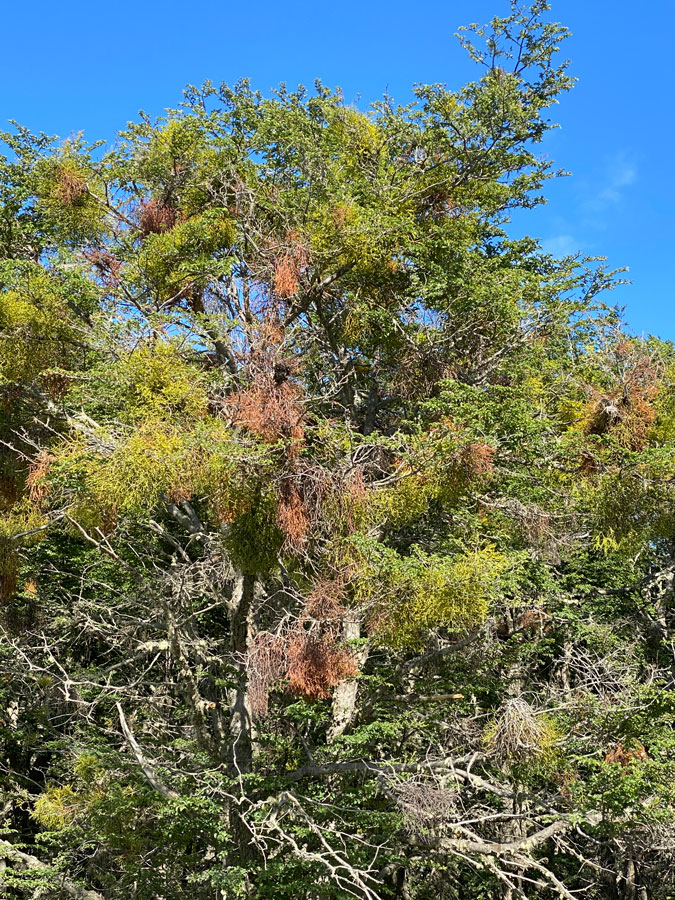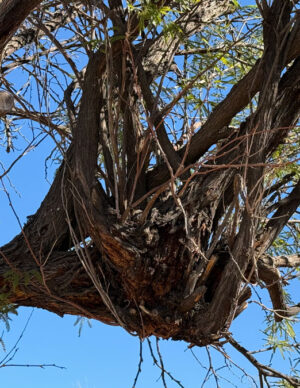Mistletoe: A Parasitic Romance
At this time of year, romantic thoughts turn to sprigs of mistletoe suspended from above, enticing revelers to a kiss. This tradition started with the ancient Romans, who hung mistletoe over their doorways to protect their households. They associated mistletoe with peace, love, and understanding. This tradition continued into the later ages, with the plant being associated with protection against demons, fertility, and vitality.
But why is mistletoe so revered? It is, after all, a parasite. A hemiparasite, to be precise. It photosynthesizes some of its nutritional needs but steals most from other plants, such as trees. Their seeds glue themselves to trees, germinate, and invade the host plant’s tissue, acquiring water and nutrients. The genus name Phoradendron means “tree thief.” As a parasite, it’s best not to kill your host. It’s a curious contradiction that a plant with such a parasitic nature is the symbol of romance.
I was reminded of mistletoe on a recent trip to Patagonia – the one at the end of South America, not the one in Arizona.

This is their native mistletoe, Misodendrum punctulatum. This native hemiparasite is seen in many of the endemic trees. The impressive winds found there spread the seeds and attach to new hosts using bristles.
This got me thinking about our native mistletoe here in the Sonoran Desert. Our native mistletoe is Phoradendron californicum, desert mistletoe, another hemiparasite. This plant provides berries that are food for many animals.
However, not all mistletoes are as benign as the native ones. One mistletoe, the dwarf mistletoe, also known as Arceuthobium, is considered invasive in western North America. It parasitizes many plants, not just trees. I suspect this invasive mistletoe is the one I have in my yard. Unlike the native species, these mistletoes end up killing their hosts, a sad reality that I find deeply concerning.
Sadly, I suspect my tree’s life will be severely shortened. I wouldn’t mind a native mistletoe, but not this invasive. I don’t think it’s romantic at all.
That brings me back to my original question; why is a parasitic plant the symbol of romance? Searching the Internet did not produce an answer, although I suspect I’m not the first person to ponder this. My conclusion is that it’s the intertwining of two plant species. The parasite draws its existence from the host tree. Mistletoe needs sustenance from another plant for its survival and growth. Perhaps this is representative of true love, as two people need each other and grow from the union. The invasive mistletoe is indicative of bad relationships, where one partner’s need overwhelms the other, love gone bad.
I still wonder about mistletoe being the symbol of romance and love, but who am I to question tradition. Discover my other blogs filled with unique perspectives on writing, nature, and, of course, science!
To learn about our latest science-based children’s books and workbooks, to read our latest blog posts about reptiles, birds, cats, and gardening, in a variety of locations, and about how the books come to be, what inspires an author to write, and many more interesting aspects of the publishing business, fill in the box below and we will add you to our email list.
Thank you!





